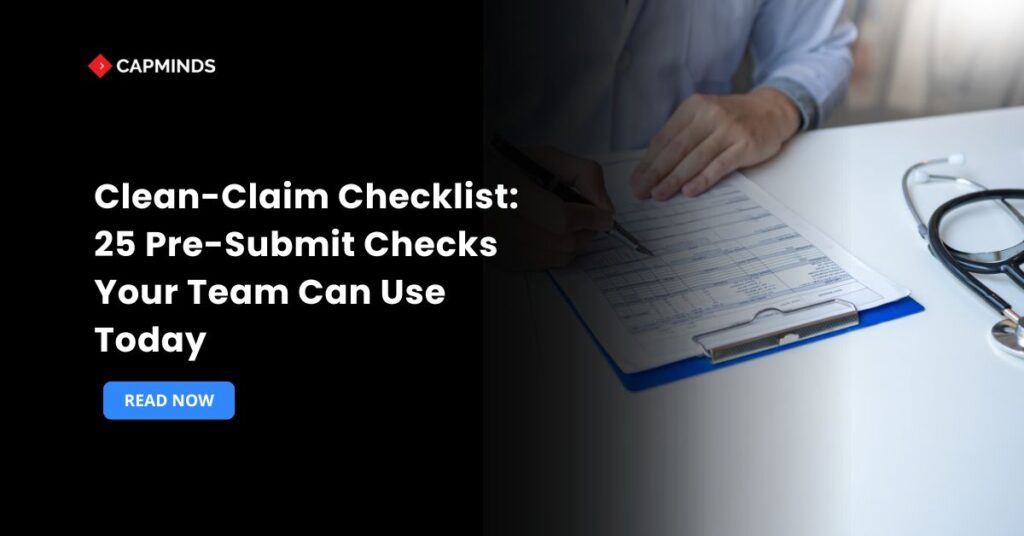Clean-Claim Checklist: 25 Pre-Submit Checks Your Team Can Use Today
Denials of claims continue to waste time and money in the US healthcare system. About 15% of claims submitted to private insurance companies are first rejected. Hospitals spent about $19.7 billion in 2022 alone to try to correct these denied claims. A large portion of that money is never retrieved. Nearly 60% of rejected claims are never sent to payers again.
An administrative burden is also added with each denial. The average cost to redo a single claim is about $25. The larger issue is that between 50 and 65 percent of denials go unanswered, resulting in wasted revenue. The good news is that the majority of these denials are avoidable. Almost 90% are associated with preventable errors, like inaccurate codes or missing patient information.
Prevention is the best course of action. Faster payments and better cash flow are guaranteed when clean claims, complete, correct, and payer-compliant, are submitted on the first try. This is where your team can benefit from our 25-point checklist.
Patient and Insurance Information
Begin by confirming the patient’s personal and insurance details are 100% accurate. Many denials occur due to simple data entry errors in demographics or insurance info. These checks ensure the basics are correct to avoid identity mismatches or coverage issues:
Patient Name & DOB
- Verify that the patient’s date of birth and full name (including spelling, middle initial, suffix, etc.) on the claim precisely match the information on the payer’s records and the patient’s insurance card.
- If the insurer is unable to identify the patient, even little differences may result in a rejection.
Patient Address
- Confirm the patient’s contact information, including their street, city, and ZIP code, is up to date and recorded accurately.
- Although incorrect addresses may not result in a denial right away, they may cause correspondence to be misdirected or patient statements to have problems.
Insurance Plan Selection
- Verify you have the correct insurance payer and plan selected for billing, not just the right company, but the specific plan or network.
- Many insurers (e.g., Blue Cross, Medicare Advantage plans) have multiple products; using the wrong plan code or address can result in denials or delays.
Member ID & Group Number
- Make sure you input the patient’s insurance member ID exactly, including any necessary prefixes or suffixes, and, if necessary, give the relevant group number.
- Since the claim won’t match any insured record, typos or missing characters in these fields will result in an instant refusal.
Coverage & Eligibility
- Verify that the services are covered by the patient’s plan and that their insurance coverage was in effect on the day of service.
- To ensure that any problems (such as an inactive policy, exhausted benefits, or need for referral) are identified early rather than after submission, it is recommended practice to do an eligibility check for every visit.
Primary vs. Secondary Payers
- Make sure you have accurately identified the primary insurer and added any information required for secondary coverage if the patient has several insurance plans.
- For secondary claims, include the primary payer’s payment information or attach the EOB as required.
- Sending a claim to the wrong primary/secondary sequence or without COB details will lead to denial for improper coordination of benefits.
Related: AI in Medical Billing: Hype vs. Real Gains in 2025
Provider and Service Details
Next, ensure all provider and service-specific details on the claim are correct. Payers will reject claims if provider information is wrong or if service location codes don’t align. These checks make sure the claim correctly identifies who provided the service, where, and when:
Billing Provider Information
- Check that the billing provider’s information (practice/facility name, NPI, tax ID, etc.) corresponds to the payer’s records.
- An incorrect NPI or tax ID can lead to outright rejection.
- Also, ensure the billing provider’s address or pay-to address on the claim is up to date and appropriate for that payer.
Rendering Provider Credentials
- If a different individual clinician (rendering/provider) is listed, confirm the rendering provider’s NPI is included and that this provider is credentialed/active with the payer.
- Many payers will deny or delay claims if the rendering provider isn’t recognized in their system (e.g. not enrolled or out-of-network without agreement).
Service Location & POS
- Make sure the service facility location is correctly indicated on the claim.
- The facility name/address or location NPI (if billing on behalf of a facility) should be accurate, and the Place of Service (POS) code should reflect where the service was provided (e.g. 11 for office, 22 for outpatient hospital).
- A wrong POS code is a common cause of claim rejection or improper payment.
Dates of Service & Units
- Ensure that each line item’s date or dates of service are accurate.
- Make sure that the claim dates and units are formatted correctly and match the paperwork if the service takes place over several days or involves a number of units (quantities) of a procedure.
- Billing mistakes or denials may arise from inconsistent or inaccurate service dates or units (e.g., missing unit count for a series of injections).
Charge Amounts
- Review each service’s billed charges to make sure they are accurately entered and match the rates specified in the payer contract or your fee schedule.
- Charge amount differences by themselves typically won’t result in a denial, but a lost decimal point or a blatantly inaccurate charge (too high/low) may draw attention.
- Making sure charges are accurate helps prevent later revisions or payment delays.
Coding and Modifiers
Correct coding is the heart of a clean claim. One of the most frequent denial reasons is a mistake in the diagnosis or treatment code. Verify that all codes and modifiers appropriately represent the services rendered and adhere to coding guidelines before submitting:
Diagnosis Code Accuracy
- Make sure that every ICD-10 diagnosis code that is utilized is accurate, precise, and suitable for the patient’s condition.
- The medical necessity of the procedure being billed should be amply supported by each diagnosis.
- Medical necessity denials may result from the use of an inaccurate or excessively generic diagnosis code.
- Make sure the codes are up to date (no expired or deleted codes) and as exact as possible (e.g., provide the fourth, fifth, or sixth character as needed).
Procedure Code Correctness
- Verify that each CPT and/or HCPCS procedure code on the claim is accurate and matches the services that were reported.
- Use the most recent set of codes; old codes will be noted (using a deleted CPT code, for example, will result in rejection).
- Double-check that you’ve selected the proper code for the exact service provided (e.g. correct level of E/M visit, correct surgical code, etc.), as even one digit off can misrepresent the service.
Code Linkage (Medical Necessity)
- To prove medical necessity, make sure each procedure that is invoiced is associated with the relevant diagnosis code or codes on the claim.
- Payers frequently reject claims if the ICD-10 code doesn’t make sense in relation to the CPT code, thus, the diagnosis should be used to support the therapy or service.
- Check your diagnosis pointers on the claim form: every procedure should point to a relevant diagnosis code that warrants that service.
Modifiers Applied Appropriately
- Make sure the modifiers used are right by going over each method for any necessary modifiers.
- Modifiers (e.g., -25 for a separate E/M service on the same day, -59 or XU for unique procedural services, -50 for bilateral, etc.) denote unusual conditions.
- Make sure a modifier is there if it is required to go around an edit or make a service more clear; on the other hand, stay away from using modifiers that aren’t appropriate.
- Modifiers should be used sparingly and only when accompanied by supporting paperwork, as they are often the reason for partial denials or decreased payouts.
Bundling and CCI Edits
- Pay attention to procedures that are not often reported simultaneously or that are bundled together.
- Verify payer restrictions and National Correct Coding Initiative (NCCI) modifications to make sure you aren’t paying for services that belong under a single code separately.
- Verify that your documentation enables unbundling codes (reporting procedures that are typically bundled) with a modifier if you are doing so for a valid cause.
- A refusal or payment reduction is likely to occur from improper unbundling.
Related: 10 Medical Billing Denial Codes That Affect Your Revenue
Documentation and Authorization
Claims may collapse even with proper coding if necessary permissions or documents are not obtained. Before submitting, confirm that you have completed all required documentation and compliance checks:
Prior Authorization & Referrals
- If pre-authorization or a referral was needed for the service, confirm that it was acquired prior to the service being rendered and that the claim contains the auth/referral number.
- If a necessary previous authorization is absent or not recorded, payers frequently reject claims outright.
- For procedures, sophisticated imaging, referrals to specialists in HMOs, and other services that frequently need approval, this is essential.
Supporting Documentation
- Verify that the claim is supported by all relevant clinical records.
- The diagnosis and services billed should be supported by the patient’s record notes, provider orders, and test findings.
- Make sure to attach or include any supporting documentation with the claim if the payer or procedure calls for it (such as radiological pictures, pathology or lab findings, operative reports for surgeries, or a Certificate of Medical Necessity for particular DME goods).
- If a necessary document is not on file, a claim that is theoretically correct may nonetheless be rejected.
Medical Necessity Evidence
- Verify again that each service’s medical need is amply demonstrated in the documentation.
- In addition to meeting the payer’s coverage requirements, the treatment must be suitable for the diagnosis.
- Before submitting, take care of any missing information in the record, such as a provider’s signature on the note or a test order.
- Payers may deny or delay claims during review if the necessity of the service isn’t evident from the submitted records.
Payer-Specific Requirements
- Verify that you have fulfilled any billing requirements particular to this payer for this claim.
- Different insurers have different policies.
- For example, Medicare may demand certain treatments to have a specific modifier or an ABN form on file, while another payer may insist on utilizing their own claim form or gateway for specific claims.
- Make sure any such nuances are handled.
- Following the insurer’s individual guidelines (formatting, coding, authorization, etc.) is part of what makes a claim “clean”.
- Ignoring payer-specific instructions can turn an otherwise clean claim into a denial.
Claim Formatting and Submission
Make these last quality checks on the claim itself before clicking “submit.” Clearinghouses or payers may reject claims right away if you make minor errors in the claim form fields or throughout the filing process.
These actions guarantee that the claim is solid technically and achieves its goals:
Complete All Required Fields
- Always make sure that all of the claim form’s mandatory fields are filled out correctly.
- This holds whether your submission is made electronically or on paper.
- Verify provider details, insurance information, and patient demographics.
- Check service dates, diagnosis codes, procedure codes, along with any modifiers and their corresponding pointers.
- Ensure that the ICD indicator, billed amounts, and units are all included and accurate.
- The claim may be rejected or refused if a required field or detail is omitted, such as the referring physician when required or accident facts when paying for accident-related therapy.
- Problems can arise even if a simple box is not marked.
- Make sure nothing is left blank by using a checklist of CMS-1500 or UB-04 necessary fields.
Clean Claim Formatting
- Verify that the claim is correctly formatted and free of technical mistakes.
- Verify that electronic entries adhere to all EDI specifications.
- This entails utilizing just authorized characters and code combinations, a legitimate payer ID, and the appropriate file format.
- Any claim that does not comply with payer-specific formatting guidelines or X12 standards will be rejected by clearinghouses.
- Use the correct form version and pay close attention to the payer’s instructions if you’re filing on paper.
- Don’t use handwritten notes or staples, and type or print the form using black ink.
- The claim may be returned unprocessed if there are minor formatting errors.
Duplicate Claim Check
- Verify that sending a duplicate claim for the same service is not an accident.
- Duplicate submissions are usually rejected by payers (for example, if the same claim has already been submitted and is still being processed).
- Unintentional duplicates often happen when checking claim status.
- Resubmitting should only be done in response to a rejection or if you are certain that the original claim was lost.
- Instead of sending a simple duplicate, utilize the appropriate coding (such as a frequency code or adjustment code) if you are submitting a corrected or secondary claim.
Timely Filing Compliance
- Make sure every claim is submitted by the payer’s deadline at all times.
- The majority of payers impose stringent time constraints, such as 90, 180, or occasionally even a year from the date of service.
- Any claim submitted beyond that time frame would be automatically denied.
- Select a submission option that provides evidence of timely filing if the deadline is approaching.
- An electronic timestamp or certified mail can be used as proof.
- In order to react promptly if an appeal is required, keep all supporting documentation on hand.
- A clean claim must be timely as well as correct.
Final Scrub & Correct Payer ID
- Run a final claims scrubber or validation tool if available, many billing systems or clearinghouses will flag any remaining errors or omissions before submission.
- This last check can catch issues like invalid diagnosis codes, missing subscriber info, or other red flags.
- Also, confirm the claim is going to the correct payer: check that the electronic payer ID or mailing address corresponds to the intended insurer and plan.
- An incorrect payer identifier will prevent the claim from ever reaching the insurer (the clearinghouse will reject it), leading to non-payment.
- A quick final glance at the destination and any clearinghouse rejection reports can save a lot of trouble.
Related: 10 Proven Strategies to Maximize Reimbursements Through Effective Medical Billing
CapMinds Medical Billing & Coding Services
At CapMinds, we understand that a seamless medical billing workflow is the backbone of a financially healthy practice.
Our comprehensive medical billing and coding services and medical billing solutions are designed to maximize revenue, reduce denials, and keep you compliant with industry standards.
With our expert team and advanced technology, we help healthcare providers stay focused on patient care while we handle the complexities of billing. Partnering with CapMinds means:
- Accurate medical coding (ICD-10, CPT, HCPCS) by certified specialists
- Streamlined claim generation, submission, and denial management
- End-to-end patient billing and collection support
- Real-time payment posting and revenue tracking
- Scalable medical billing solutions tailored to your practice size
Whether you’re a small clinic or a multi-specialty provider, CapMinds ensures a transparent, efficient, and reliable billing process.
Let us be your trusted medical billing company and take your revenue cycle performance to the next level.




